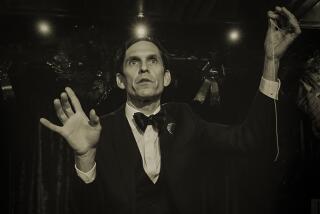Corona del Mar’s Magician to the Stars
- Share via
While most people hope to put just a little magic in their lives, Louis St. Pierre’s whole existence is magic.
Forty-one years ago, he walked into a magic store to buy rope for a trick and came away with the whole ball of yarn: He bought the store and became known as the magician to the stars.
They all come to him--the stars, the children, the man off the street. Anyone who’s looking for a way to fool or amuse a friend winds up at one of his Hollywood Magic stores, either in Hollywood or in Costa Mesa (“Costa Mesa Magic” just doesn’t have the same ring to it).
His regular clients include Steve Martin (where do you think Martin got his first arrow through the head?), Johnny Carson, Muhammad Ali and Michael Jackson (at least it looks like Michael Jackson behind that surgical mask).
“Steve Martin has been coming in for 15 or 20 years,” said St. Pierre, 62. “After he (became a big star with) the arrow through the head, we must have sold 10,000, maybe even 20,000. I was ordering them by the gross, and I still couldn’t get enough of them. In fact, I even had one guy making them for me, by hand. And then we bought all the arrows out and started to look for cheap arrows in bow-and-arrow sets.”
The ideas may be stale, but sales of thousands of whoopee cushions, cans of peanut brittle with snakes in them and sets of linking rings have left St. Pierre comfortably ensconced in a million-dollar hilltop home in Corona del Mar. He said he could retire today, but where else could he see Michael Jackson without standing in line or buying a ticket?
Jackson has “been coming in pretty regularly,” St. Pierre said. “We let him in the back door because the store would be taken over if they knew he was in there. He comes in with a couple of bodyguards, and he even wears the little mask once in a while. But he’s a very nice young man. He loves coin tricks and close-up magic.”
Former heavyweight boxing champion Ali is another whose presence does not go unnoticed, especially when he is accompanied by his entourage. “He buys small things, things you can carry around with you. He just does a few silk tricks. He doesn’t do anything against his religion, though, so he doesn’t do anything that has to do with cards.”
Coming from a show business family himself, St. Pierre is not awed by the clientele. His father was a circus performer (magic, juggling, acrobatics), and his mother was a vaudeville dancer. “They met on stage and were married for 52 years,” he said.
“Dad always did magic,” said St. Pierre, adding that his own interest didn’t blossom until he entered the Army, where he “entertained at a few USO things.”
“It was tougher to learn magic in those days. There was no access. For instance, at the National Magic Co. in Chicago there was nothing on display. You couldn’t see anything because everything was wrapped up. They might (demonstrate something), but normally you thumbed through a catalogue and picked something out.
“At that time, there were only four magic shops in the country--Tannens in New York City, Abbotts in Colon, Mich., National in Chicago and Bert Wheeler’s in Hollywood.”
The St. Pierres came to Southern California hoping to start a restaurant business after World War II. One day St. Pierre walked into Wheeler’s to buy some rope and cards.
“It was purely a coincidence,” he said. “There was no for-sale sign. I asked where Wheeler was. His sisters, who were running the store, said it was for sale because he had recently died in a plane crash. . . . My dad and I bought the store for $14,000.”
They quickly realized that magic shops couldn’t make it just selling magic. “You had to have novelties and jokes--whoopee cushions, joy buzzers--to keep the business going. There just were not enough working performers around to keep you alive.
“I started doing shows on the side to make ends meet. I remember a little nightclub out in the (San Fernando) Valley called the Hat and Cane, where I used to work six nights a week after I closed the store. I went out there and did two shows a night. They had a stripper, comedian and me. It paid $50 a week and all I could eat, which was a lot of money in those days.”
He also was able to get jobs through customers and did some film work. “They would use my hands, especially in the Western poker scenes.”
The magic business didn’t really take off in Southern California, he said, until the Magic Castle--a private magicians’ club--opened 25 years ago in Hollywood. St. Pierre was one of the original 250 charter members. Membership is currently at 6,000.
As the Castle’s clientele grew, so did St. Pierre’s business. In 1971, he split the magic from the toy store and eventually sold the latter. In 1976, he opened his store in Costa Mesa and decided that he “wouldn’t mind living down here.”
The upsurge of public interest in magic, thanks in large part to Doug Henning, David Copperfield and Siegfried and Roy, has also kept his business humming. And St. Pierre takes off his top hat to them.
“They know more now (than we did),” he said. And while he says today’s performers are “slicker and perform more professionally,” he doesn’t believe that they are better showmen. “We had to be better showmen because the magic wasn’t as good.”
And St. Pierre has done his part to educate today’s magicians, stocking more than 5,000 books on magic in his stores. He said he could remember only one such book when he was growing up. The success of magic is fairly simple, according to St. Pierre. “People love to fool other people . . . and people love to be fooled.”



